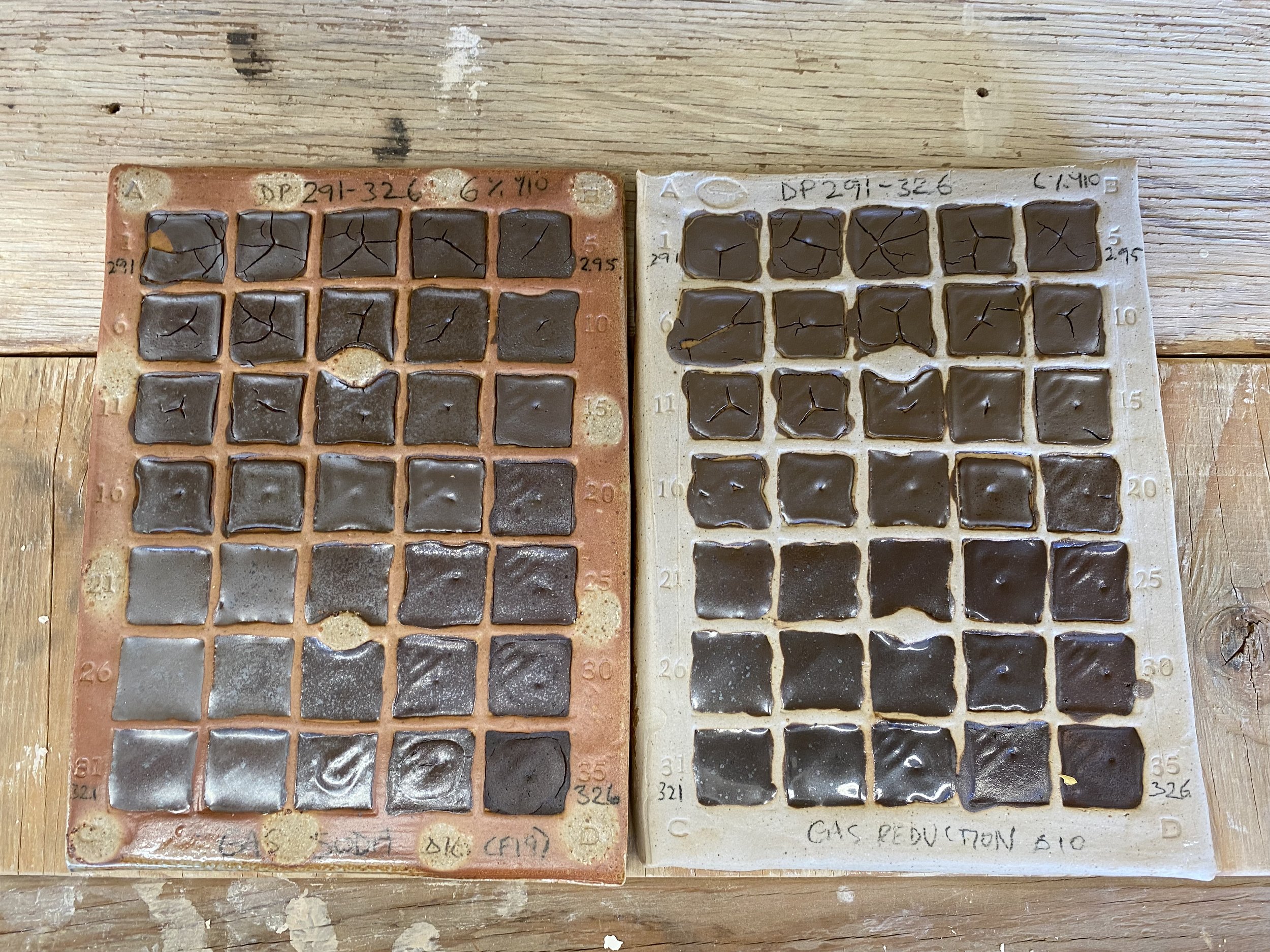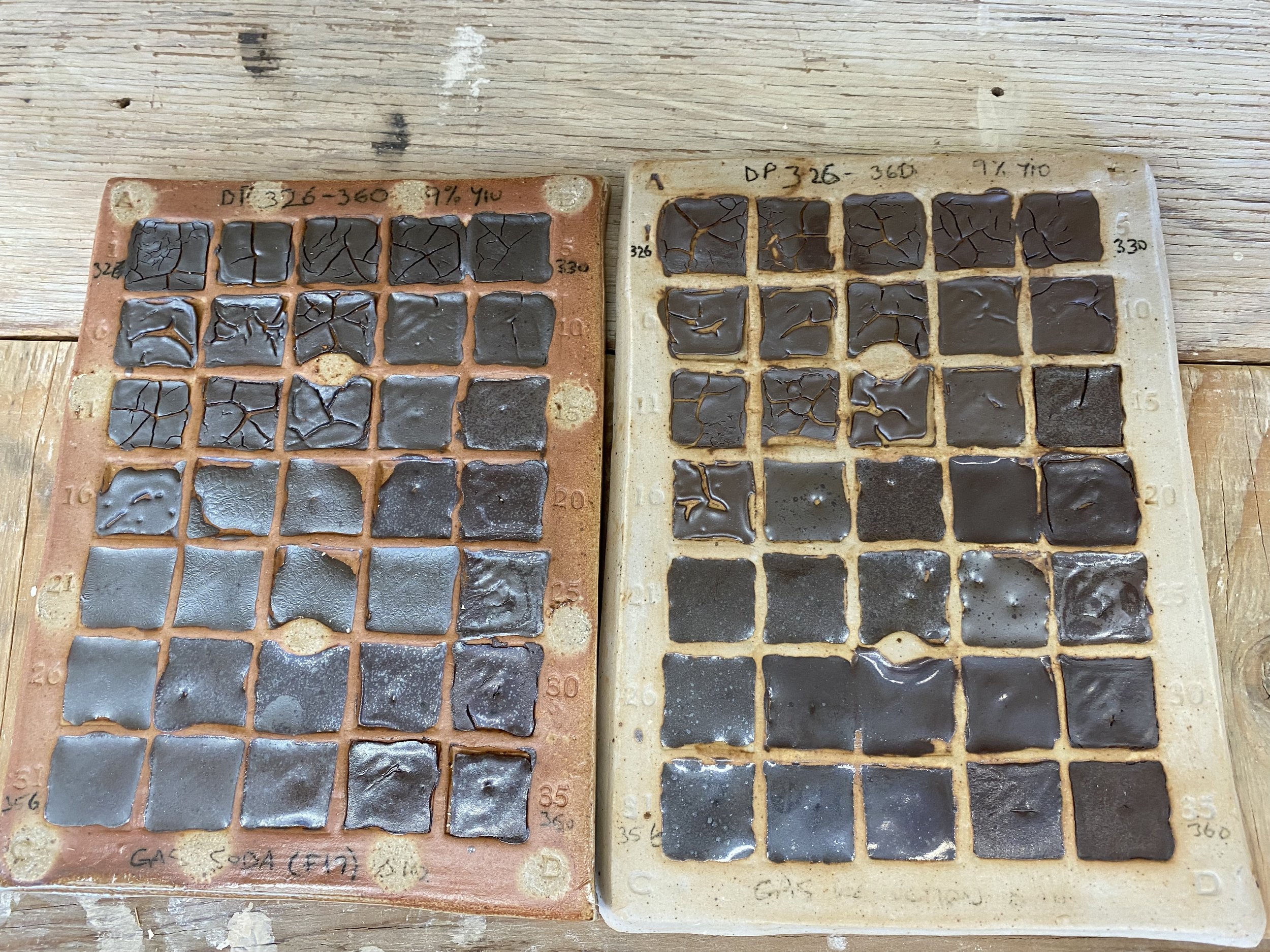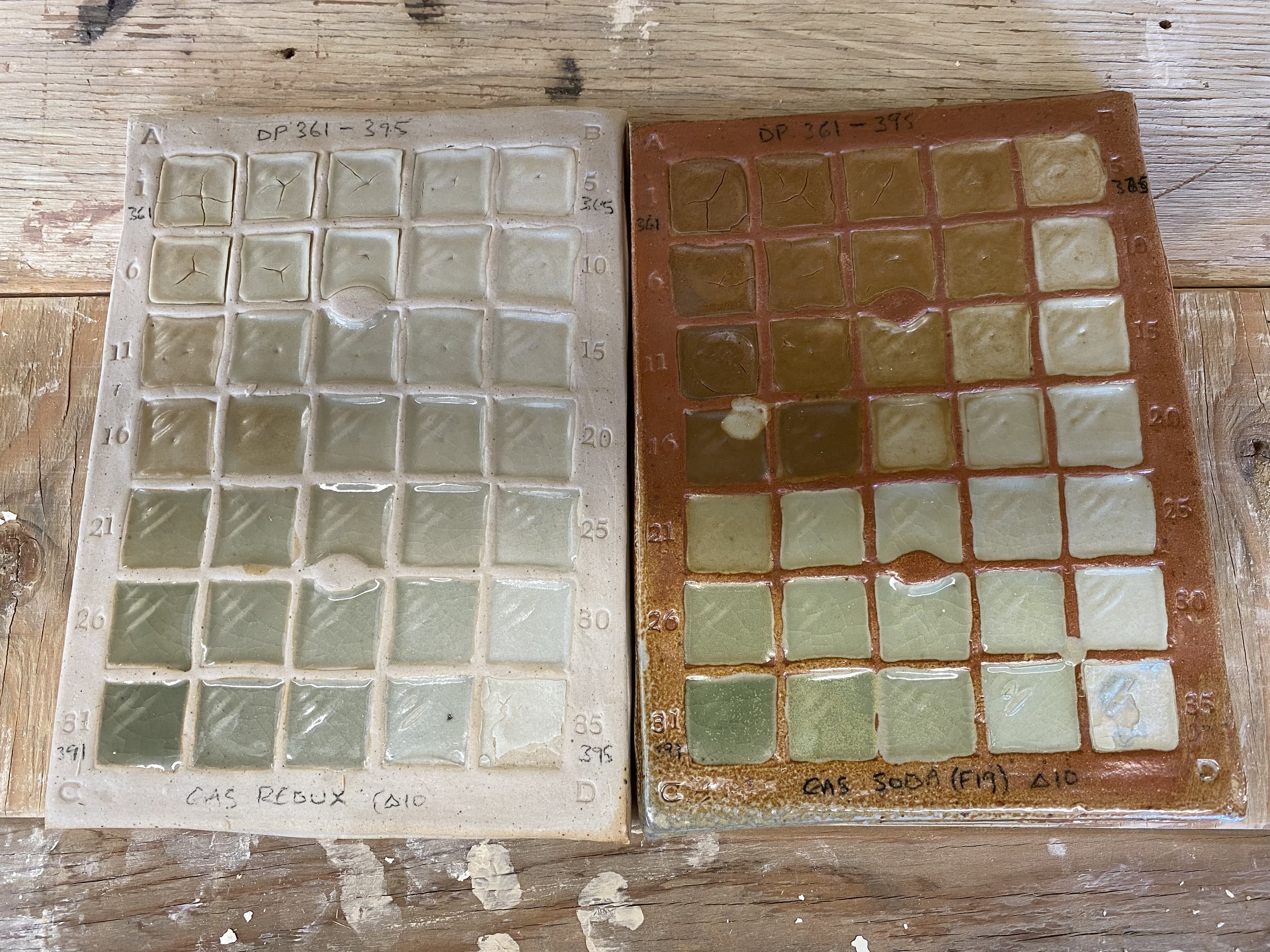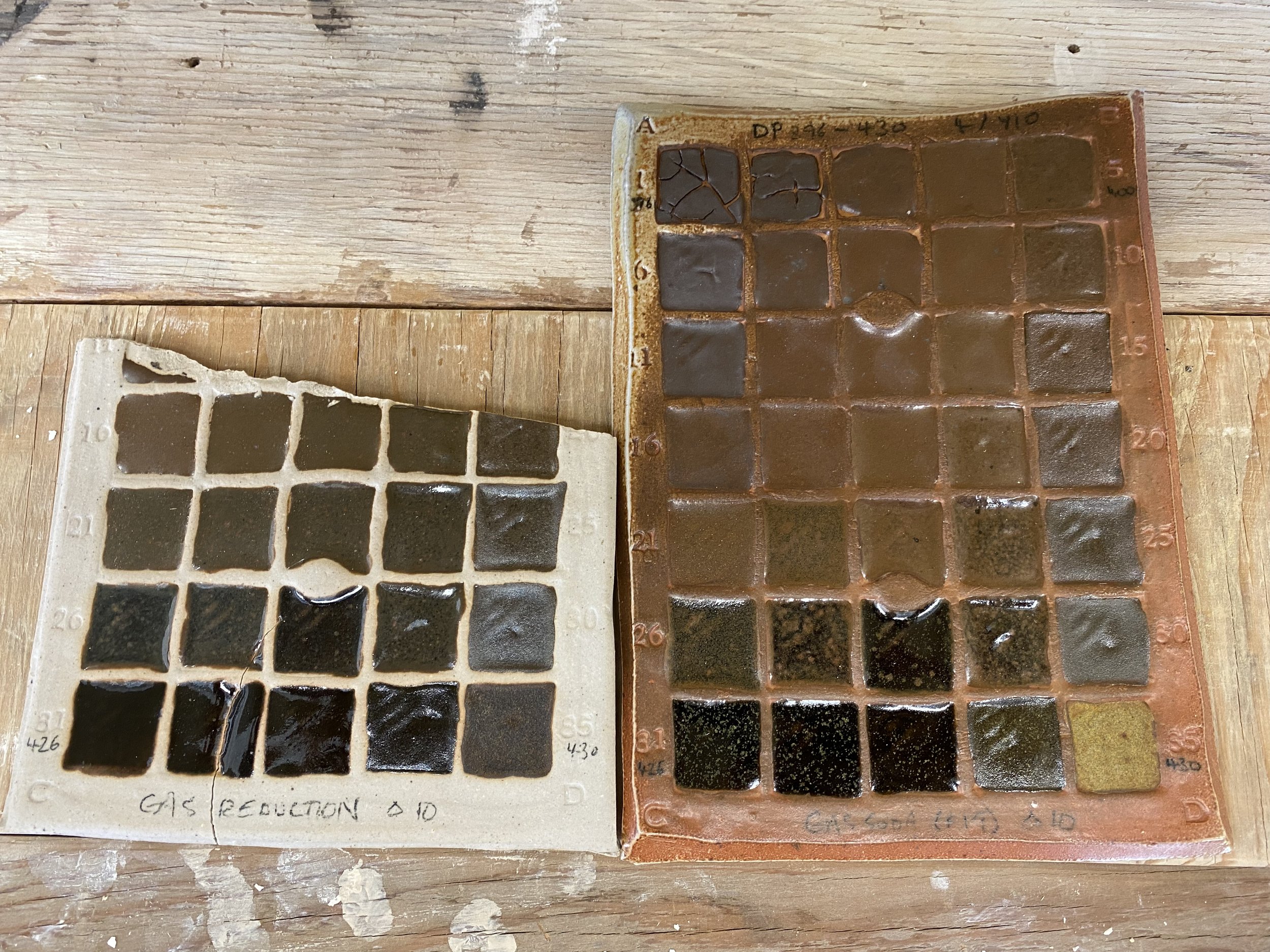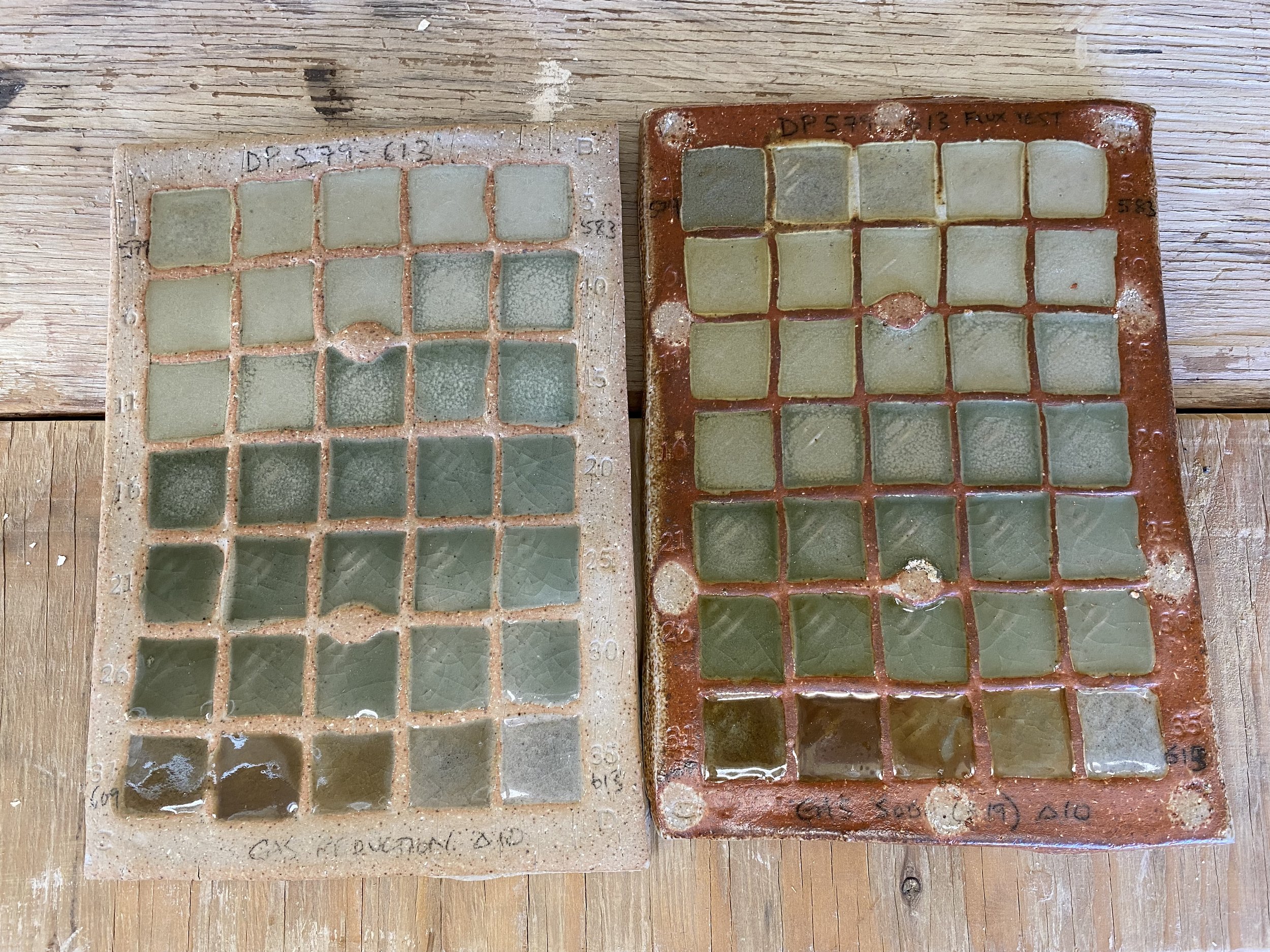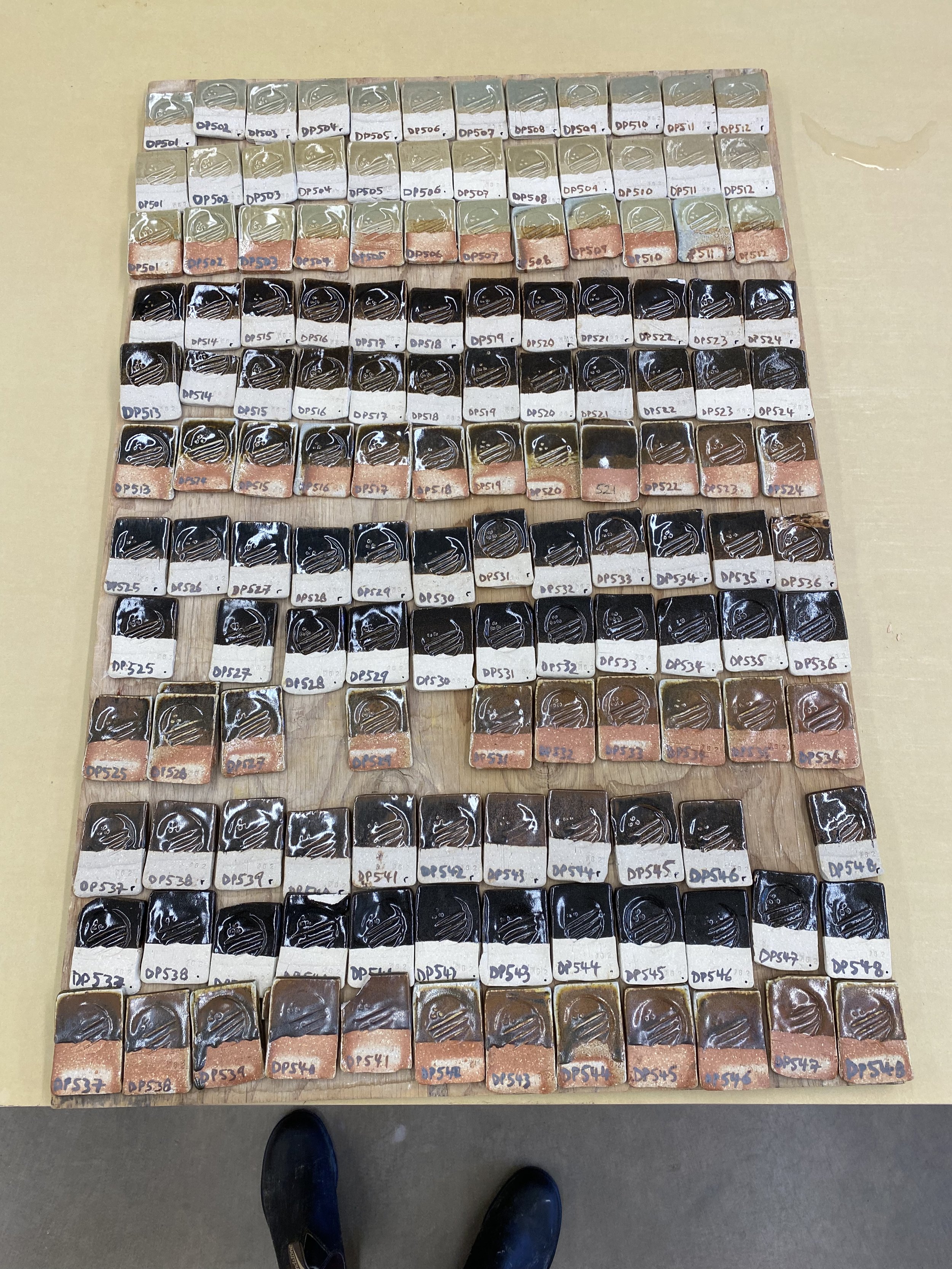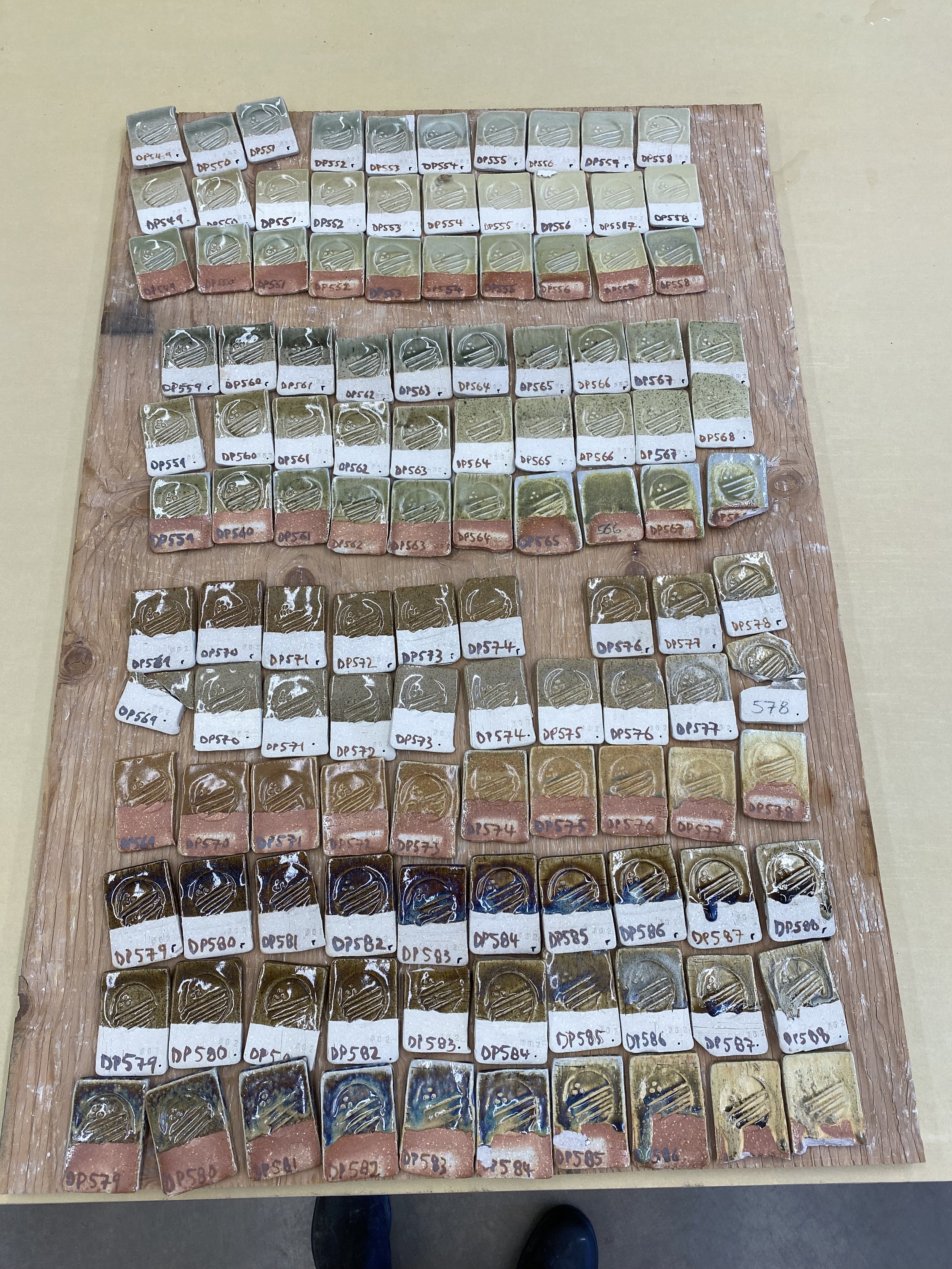Devil's Playground Granite Glaze Tests Round 2: Pictures with notes
The first test here is to see how the granite responded to increases in silica and alumina. Basically this was to see if the granite was deficient in either. I used Ian Currie’s sample Earthenware set but subbed in my granite for the ferro frit. I made up 4 corner glazes and then mixed 35 glazes from these. Each corner glaze is made from 300g material and topped up to 500ml.
Corner A Glaze contains 120g EPK (Edgar Plastic Kaolin) to 180g granite. This is our high alumina corner.
Corner B Glaze contains 75g EPK, 120g silica and 105g granite. This is our high alumina, high silica corner (low flux).
Corner C Glaze contains 300g granite. This is our high flux corner.
Corner D Glaze contains 150g silica and 150g granite. This is our high silica corner.
DP 221-255
What do we notice from these tests?
Corner C is the granite on its own. It melts at cone 10 and is pretty much a glaze on its own! In fact out of all of these tests corner c is about the nicest.
As we might expect, the corners A, B and D were not successful glazes. They were each too refractory and did not melt. In fact, from this initial test I can conclude that the granite has plenty of alumina and silica already. But it can take some alumina and silica, which may be helpful if I need to adjust it to fit the body better: ie. if I have crazing issues I can add some silica to the glaze without it drastically altering it.
The soda seems to be encouraging a more chestnutty brown color overall. Not particularly pleasant! Number 25 in this grid of 35 looks like a potentially nice shino style glaze in soda though.
Overall far too many of these tests are dry… the whole set needs more flux added.I can conclude from this that my granite needs flux added.
Here is the sheet showing the % of what each of these glazes are. This grid method comes from Ian Currie by the way. He has a couple of excellent books out there detailing how to do it.
Adding iron to this initial set did not improve matters. It needs more flux clearly. Below is the same grid test but with 4%, 7% and then 9% yellow iron oxide.
DP 256-290 (same grid as 221-255 with 4% iron oxide added).
DP 291-326 (same grid as 221-255 with 7% iron oxide added).
DP 326-360 (same grid as 221-255 with 9% iron oxide added).
In this next set I used the same exact table of kaolin and silica but added 10% lime and 10% minspar to the base granite (DP31). Using this as my corner C I ran the same set of tests. These were more successful, with the 9 glazes in the bottom left of the grid all being reasonably successful. Adding more flux certainly helped.
Compare this with the first picture of the blog… this is the difference in adding just 10% lime and 10% minspar. Much nicer results… the brown swathe of glazes is receding! I could push this further though-adding more than just 10% lime and minspar.
Here is the sheet showing the % of what each of these glazes are.
Below is this same set (DP361-395) with 4%, 7% and then 9% yellow iron oxide added.
DP 396-430 (same grid as 361-395 with 4% iron oxide added).
DP 431-465 (same grid as 361-395 with 7% iron oxide added).
DP 466-500 (same grid as 361-395 with 10% iron oxide added).
What do we note from these iron additions?
10% is overkill… the glaze becomes oversaturated and goes a kind of gun metal matte brown/black. The 4% ones look the brightest to me, more so than the 6% gang.
There was some exciting red spots in the bottom row of the 6% tests though. This happened more in the 4$ tests in soda. In general the soda tends to matte out the glazes a bit. Definitely a tenmoku to be found here though! Quite excited about some of these results.
. . .
In this grid set I made a fluxier test. I have been using 10% lime and 10% minspar as a basic addition to my Devil’s Playground granite (DP31) but wanted to see what happened if I added more than this.
Corner A Glaze contains 120g lime/whiting (40%) to 180g granite (60%). This is our high lime corner.
Corner B Glaze contains 75g lime (25%), 120g minspar (40%) and 105g granite (35%). This is our really high flux corner.
Corner C Glaze contains 300g granite (100%). This is our pure granite glaze.
Corner D Glaze contains minspar (50%) and 150g granite (50%). This is our high soda feldspar corner.
Results of the test above: curious results! Where too much lime is included we get matte glazes, even in reduction (around corner A). The same does not happen around Corner D. This is the high minspar corner. In general the soda makes the glaze more matte and more green compared to the straight gas reduction.
There are quite a few decent glazes in this grid test though. We can conclude that the granite wants more flux but not too much (in terms of lime we start to get matte crystals at glaze 18 which has 16.25% lime and 22.5% minspar. For the pure lime it starts to get cloudy at 20%. I can conclude from this that 15% is probably the max lime content I want unless I am shooting for a matte glaze. The grid tests are fantastic but don’t show how drippy the glazes will be. I need to run this test with vertical test tiles too.
Minspar tends to send the glaze grey on its own so a blend with lime is good for the bluer color.
Here is the sheet showing the % of what each of these glazes are.
Next up I added bone ash to DP31 (the fluxier base granite glaze which has 80% granite, 10% lime and 10% minspar in it). DP501 has 1% bone ash in it, Dp502 has 2% and so on up to 10% at DP510. Then DP511 has 15% bone ash and DP512 has 20% added. Then the next set of three DP513-524 is the same base glaze but with 4% yellow iron oxide added. The next set DP525-536 is the same base glaze but with 7% yellow iron oxide added. The next set DP537-548 is the same base glaze but with 10% yellow iron oxide added.
The tests were all fired to cone 10. The top line of each of these tests is in reduction, the second set is gas oxidation and the final is gas soda.
Here are the tests individually so we can see them a little easier. This is the straight up bone ash additions (to DP31): 1,2,3,4,5,6,7,8,9,10,15,20%.
DP31 glaze with bone ash additions: 1,2,3,4,5,6,7,8,9,10,15,20%.
Generally the oxidation ones tend to be greener and the reduction ones bluer. The bone ash doesn’t have a huge impact until about 6% is added, then the glazes start to get a bit cloudier. This progresses all the way up to 20%. None are fully matte though. I was hoping for a greater impact from the bone ash frankly… aiming at a chun. More testing needed to get there!
In soda the glazes were greener and satiny: the bone ash did not have a huge impact.
Now here is the same tests with 4,7,10% yellow iron oxide added…
DP31 glaze with bone ash additions: 1,2,3,4,5,6,7,8,9,10,15,20%. Plus 4% iron oxide.
The addition of 4% iron led to a greenish black in oxidation and reduction… not particularly attractive when thin. In soda there was some potential in the 10-20% bone ash zone. Some nice reddish flecks happening there.
DP31 with bone ash additions: 1,2,3,4,5,6,7,8,9,10,15,20%. Plus 7% iron oxide.
The 6% addition of iron made the tests richer in oxidation and reduction. In reduction they were more interesting: got some red/brown flecks in the black. The flecks were there even from 1% bone ash upwards: not a big difference between them.
The soda tests were affected heavily. The tests got redder and increasingly interesting. 20% is pretty cool!
DP31 glaze with bone ash additions: 1,2,3,4,5,6,7,8,9,10,15,20%. Plus 10% iron oxide.
The 10% addition did’t change much in oxidation but reduction ones were quite interesting. John says these could do with more flux but could be nice. More running! I do like DP542-545 especially. Test more around this area.
In soda the glazes did start to run where hit heavily. Nice red flecks though! DP545-8 to be pursued for sure.
Okay, next set. In this one I am aiming at a yellow mate glaze.
In the first set (the top 3 rows) I added dolomite. DP549 has 2% dolomite added, DP550 has 4% DP551 has 6%, DP552 has 8%, DP553 has 10%, DP554 has 15%, DP555 has 20%, DP556 has 25%, DP557 has 30%, DP558 has 40%. In the second batch of tests here I added 1% yellow iron oxide. In the third batch I added 10% zircopax and then finally 6% titanium dioxide.
Here are the tests individually. First set with just the dolomite additions.
DP31 glaze with dolomite additions, from left to right: 2%, 4%, 6%, 8%, 10%, 15%, 20%, 25%, 30%, 40%.
Results from the test above: we can see that the reduction tests are bluer, the oxidation ones greener and the soda ones are a darker, more matte, green. In general with all of the tests as you add more dolomite they get lighter in color and a matter surface.
In the oxidation and reduction tests it takes 10/15% to matte out the glaze. In the soda they were all pretty matte, but certainly from 4% upwards. Progressively so! More flux necessary to balance this out. Although none of these were that exciting to me.
DP31 glaze with dolomite additions, from left to right: 2%, 4%, 6%, 8%, 10%, 15%, 20%, 25%, 30%, 40%. Plus 1% iron oxide!
Results from the test above: these were similar to the DP549-558 above, just a shade darker, and a bit fluxier. This is what I would expect from a 1% iron addition. DP562-4 were pretty nice in reduction I think: compare to my wood ash tests.
DP31 glaze with dolomite additions, from left to right: 2%, 4%, 6%, 8%, 10%, 15%, 20%, 25%, 30%, 40%. Plus 1% iron oxide AND 10% zircopax.
Results from the picture above: the gas and oxidation ones were fairly mankey (english for gross) as were most of the soda ones… until DP577-8. DP578 is full on yellow! This is very exciting. I need to do more testing around this as it is fairly drippy here but definitely close to a finished glaze I reckon. I wonder what it would look like with different levels of iron. Maybe some tin to brighten it. Perhaps some silica or clay to stop it melting too much.
Here’s that tile on its own…
Now I added 6% titanium dioxide to this whole set of tests.
DP31 glaze with dolomite additions, from left to right: 2%, 4%, 6%, 8%, 10%, 15%, 20%, 25%, 30%, 40%. Plus 1% iron oxide AND 10% zircopax AND 6% titanium dioxide.
Overall I’m not super into these. The titanium makes some crazy blue/purple hazy business happen. It also makes the glazes much more melty. The ones with 30/40% dolomite ran a whole lot in the soda. The yellow is still there but has a greener cast. The winner is still DP578 from this batch of tests I think.




